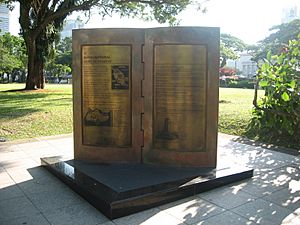Indian National Army facts for kids
Quick facts for kids Indian National Army |
|
|---|---|

Former Indian National Army Monument
|
|
| Active | August 1942 – September 1945 |
| Role | Guerrilla, infantry, special operations |
| Size | 43,000 (approximate) |
| Motto(s) | Ittehad, Itmad aur Qurbani (Unity, Faith and Sacrifice in Urdu) |
| March | Kadam Kadam Badaye Ja |
| Engagements | World War II |
| Commanders | |
| Ceremonial chief | Subhash Chandra Bose |
The Indian National Army (INA) was a special army formed by Indian people in 1942. It was created in Southeast Asia during World War II. The main goal of the INA was to help India become free from British rule. This army worked with Imperial Japan during their battles in World War II.
The INA was first started in 1942 by a leader named Mohan Singh Deb. Many of its first soldiers were Indian prisoners of war (PoWs). These were soldiers from the British-Indian Army who were captured by Japan in battles like the Malayan campaign and the Battle of Singapore.
Contents
The First Indian National Army
The first INA did not last very long. It was stopped in December 1942. This happened because the INA leaders and the Japanese military had disagreements. They could not agree on what role the INA should play in Japan's war in Asia.
The Revival Under Subhash Chandra Bose
The INA was brought back to life in 1943. This happened when a famous Indian leader, Subhash Chandra Bose, arrived in Southeast Asia. Under Bose's leadership, the army was announced as the official army of his government. This government was called Arzi Hukumat-e-Azad Hind, which means the Provisional Government of Free India.
Bose's INA grew much larger. It included former prisoners of war. It also had thousands of everyday people who volunteered. These volunteers were Indians living outside India, especially in Malaya (now Malaysia) and Burma.
INA in Battle
The second INA fought alongside the Japanese Army. They battled against the British and other Allied forces. Some of the major battles they took part in were in Burma, Imphal, and Kohima. Later, they also fought during the successful Burma Campaign by the Allies.
Legacy and Recognition
After the war, there were different views about the INA members. Some British soldiers and Indian PoWs who did not join the INA saw them as people who helped the Axis powers. However, many Indians saw them as brave patriots who fought for their country's freedom.
The Indian National Congress, a major political party, honored the INA members after India became independent. But the Government of India did not give them the official status of "freedom fighters." This was different from those who joined Mahatma Gandhi's peaceful movement for independence.
Even today, the Indian National Army remains a very popular and important topic. People in India often talk about it in their culture and politics.
Images for kids
-
Bose meeting with Adolf Hitler in East Prussia, May 1942
-
Subhas Bose with Mohandas Gandhi at a Congress meeting, c 1930
-
Lakshmi Sahgal in later life, at a political meeting in India
-
Postage stamps released by Indian National Army in display at Netaji Birth Place Museum, Cuttack
See also
 In Spanish: Ejército Nacional Indio para niños
In Spanish: Ejército Nacional Indio para niños










